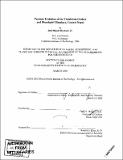| dc.contributor.advisor | Kip V. Hodges. | en_US |
| dc.contributor.author | Hurtado, José Miguel, 1974- | en_US |
| dc.contributor.other | Massachusetts Institute of Technology. Dept. of Earth, Atmospheric, and Planetary Sciences. | en_US |
| dc.date.accessioned | 2006-06-20T12:52:05Z | |
| dc.date.available | 2006-06-20T12:52:05Z | |
| dc.date.copyright | 2002 | en_US |
| dc.date.issued | 2002 | en_US |
| dc.identifier.uri | http://hdl.handle.net/1721.1/33160 | |
| dc.description | Thesis (Ph. D.)--Massachusetts Institute of Technology, Dept. of Earth, Atmospheric, and Planetary Sciences, June 2002. | en_US |
| dc.description | This electronic version was submitted by the student author. The certified thesis is available in the Institute Archives and Special Collections. | en_US |
| dc.description | Pages 460-462 blank. | en_US |
| dc.description | Includes bibliographical references. | en_US |
| dc.description.abstract | Three extensional fault systems intersect in the central Nepal Himalaya: the South Tibetan fault system (STFS); the Thakkhola graben; and structures bounding the Upper Mustang Massif (UMM). Interactions between these systems are investigated using integrated field studies, remote sensing analyses, geodynamic modeling, and a wide variety of geochronologic tools. The goals are to characterize the relationships between the three extensional systems, document their neotectonic histories in relation to their older manifestations, and develop a model for how the geodynamic phenomena driving them have produced the observed patterns of tectonism and deformation. 14C geochronology, remote sensing analyses, and field observations in the southern Thakkhola graben show that the STFS has been active in the Quaternary and that the kinematically-linked Thakkhola graben acts as a tear structure in its hanging wall. In the northern Thakkhola graben, neotectonic, structural, and 40Ar/39Ar and U-Pb geochronologic data from the UMM record its Late Miocene to Quaternary exhumational history and reveal a kinematic and geometric relationship between core-complex extension in the UMM and rift extension in the Thakkhola graben. | en_US |
| dc.description.abstract | This work shows that core-complex development and east-west extension in southern Tibet are closely related to the STFS. In the adjacent Dhaulagiri Himalaya, remote sensing and field analyses of several generations of STFS structures - some of which appear to be active - show that the most recently active fault traces do not necessarily follow pre-existing lithologic contacts defined by older strands, but instead follow less contorted traces, cutting across allochtons and even reactivating segments of the Main Central Thrust. The distribution of high-grade rocks and the interactions between the STFS, east-west extension, and core-complex development are hypothesized to reflect the response of the orogen to gravitational potential energy (GPE) anomalies. GPE anomalies in the Himalaya are calculated from geoid data and interpreted in terms of pressure gradients driving flow in an intracrustal channel. From the distribution of GPE anomalies, I suggest that orogen parallel flow may be as significant as orogen-perpendicular flow, indicating that both removal and redistribution of GPE is important in the development of extensional structures in the Himalayan orogen and in southern Tibet. | en_US |
| dc.description.statementofresponsibility | by José Miguel Hurtado, Jr. | en_US |
| dc.description.tableofcontents | Contents of CDROM: Standard Adobe PDF files of the disserataion -- PDF compatible (Adobe Illustrator) files of the official defense notices -- Microsoft Powerpoint presentation used during the defense talk -- Apple Quicktime animation of the Powerpoint slides -- Standard Adobe PDF of the author's CV. | en_US |
| dc.format.extent | 462 p. | en_US |
| dc.format.extent | 106981965 bytes | |
| dc.format.extent | 106981560 bytes | |
| dc.format.mimetype | application/pdf | |
| dc.format.mimetype | application/pdf | |
| dc.language.iso | eng | en_US |
| dc.publisher | Massachusetts Institute of Technology | en_US |
| dc.relation.requires | "ISO 9660 Format CD-R, 382 MB, readable on Macintosh, Windows & UNIX systems"--Container. | en_US |
| dc.rights | M.I.T. theses are protected by copyright. They may be viewed from this source for any purpose, but reproduction or distribution in any format is prohibited without written permission. See provided URL for inquiries about permission. | en_US |
| dc.rights.uri | http://dspace.mit.edu/handle/1721.1/7582 | |
| dc.subject | Earth, Atmospheric, and Planetary Sciences. | en_US |
| dc.title | Tectonic evolution of the Thakkahola Graben and Dhaulagiri Himalaya, Central Nepal | en_US |
| dc.type | Thesis | en_US |
| dc.description.degree | Ph.D. | en_US |
| dc.contributor.department | Massachusetts Institute of Technology. Department of Earth, Atmospheric, and Planetary Sciences | |
| dc.identifier.oclc | 51043933 | en_US |
